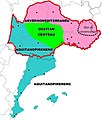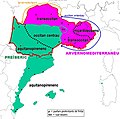"Languedocien" redirects here. For other uses, see Languedoc.
| Languedocian | |
|---|---|
| lengadocian | |
| Native to | France |
| Region | Southern France |
| Native speakers | (undated figure of 5,000) |
| Language family | Indo-European |
| Language codes | |
| ISO 639-3 | lnc (retired); subsumed in oci |
| Glottolog | lang1309 |
| ELP | Languedocien |
| IETF | oc-lengadoc |
 The extent of Languedocien in the Occitan area The extent of Languedocien in the Occitan area | |
Languedocien (French name, pronounced [lɑ̃ɡdɔsjɛ̃]), Languedocian, or Lengadocian (Occitan pronunciation: [ˌleŋɡɔðuˈsja]) is an Occitan dialect spoken in rural parts of southern France such as Languedoc, Rouergue, Quercy, Agenais and Southern Périgord. It is sometimes also called Languedocien-Guyennais. Due to its central position among the dialects of Occitan, it is often used as a basis for a Standard Occitan.
About 10% of the population of Languedoc are fluent in the language (about 300,000), and another 20% (600,000) "have some understanding" of the language. All speak French as their first or second language.
Geographic distribution
Languedocien is spoken in certain parts of three French regions.
- Occitanie: Aveyron, Lot, Tarn, Tarn-et-Garonne except Lomagne, Ariège (except a western part), Haute-Garonne (except the districts of Saint-Gaudens and Muret), Aude, Hérault, Lozère, western and northern parts of Gard and Fenouillèdes.
- Nouvelle-Aquitaine: south of the Dordogne, east of the Gironde, north-eastern two-thirds of Lot-et-Garonne, the southern fringe of Corrèze.
- Auvergne-Rhône-Alpes: area of Bas-Vivarois, Languedocien-Nord-Cévenol
Other dialects spoken in these areas include: Gascon, Catalan, Limousin, and Auvergnat, as well as the unrelated Basque language.
Characteristics
The following are the main characteristics of the Languedocien dialect:
- occlusives are kept at the end of a word: cantat (in Provençal: );
- preservation of the final s of a word: los òmes (in Limousin: );
- the final n of a word is dropped: occitan (in Provençal: );
- absence of palatalisation of CA and GA groups: cantar, gal (in Auvergnat: chantar, jal);
- preservation of the final l of a word (i.e. not vocalised): provençal (in Provençal and in Gascon: provençau);
- lack of distinction between the sounds b and v (betacism): vin (in Auvergnat, Limousin and Provençal: , , ).
None of these characteristics are unique to Languedocien; many are shared with one or more other Occitan dialects. Languedocien is both a central and conservative dialect. For these reasons, certain linguists are in favour of a standardisation of Occitan using Languedocien as a basis for this.
Variations

Languedocien encompasses a number of variations, the classification of which is still ongoing.
Jules Ronjat gives three sub-groups:
- Eastern Languedocien dialects: Alésien, Montpelliérain, Lodévois, and Bitterrois (the latter tending towards Western Languedocien).
- Western Languedocien dialects: Narbonnais, Carcassonnais, Toulousain (including Fuxéen and Capcinois), Albigeois, Montalbanais, Agenais (the latter tending towards Guyennais and Gascon).
- Guyennais dialects: Rouergat, Gévaudanais (Lozère, Cévennes), Quercinois, Aurillacois, Sarladais, Bergeracois.
- He also classes Bas-Vivarois as a Languedocien dialect but separate from the above categories.
Louis Alibert uses four sub-groups:
- Eastern dialects: Cévenol, Montpelliérain, Bitterois.
- Southern dialects: Toulousain, Fuxéen, Donezanais, Narbonnais, "Central" (Carcassonais), Agenais.
- Western dialects: Bergeracois, Villeneuvois, Sarladais, Haut-Quercinois, Bas-Quercinois, Albigeois.
- Northern dialects: Aurillacois, Rouergat, Gévaudanais.
Domergue Sumien defines the categories thus:
- Eastern dialects: Cévenol, Montpelliérain.
- Southern dialects: Toulousain, Fuxéen, Donezanais, Narbonnais, Carcassonais.
- Western dialects: Bas-Quercinois, Albigeois, Agenais, Bitterois.
- Northern dialects: Bergeracois, Villeneuvois, Sarladais, Haut-Quercinois, Aurillacois, Rouergat, Gévaudanais, Bas-Vivarois.
In their supra-dialectal classification of Occitan, Pierre Bec and Domergue Sumien divide Languedocien into one or two supra-dialectal groups:
- Pierre Bec places Southern Languedocien dialects in the Aquitanian-Pyrenean group and the rest of the Languedocien dialects in the Central Occitanian group.
- Domergue Sumien classifies these Languedocien dialects similarly, but groups both Aquitanian-Pyrenean and Central Occitanian under the title of Pre-Iberian.
-
 Supradialectal classification of Occitan according to P. Bec
Supradialectal classification of Occitan according to P. Bec
-
 Supradialectal classification of Occitan according to D. Sumien
Supradialectal classification of Occitan according to D. Sumien
Usage
With the absence of a linguistic census, it is difficult to obtain exact figures on the number of speakers. The most recent global studies on Occitan say the number of speakers ranges from 500,000 to 700,000 for the language as a whole. UNESCO, which is the only organisation to treat Languedocien independently, estimates the number at around 500,000, and considers the language under serious threat.
See also
- Occitan conjugation
- Languages of France
- Langue d'oc
- Émile Mazuc, scholar of the Languedocien language
References
- Languedocien at Ethnologue (15th ed., 2005)

- "Occitan (post 1500)". IANA language subtag registry. 18 August 2008. Retrieved 11 February 2019.
-
Error: Unable to display the reference from Wikidata properly. Technical details:
- Reason for the failure of {{Cite web}}: The Wikidata reference contains the property subtitle (P1680), which is not assigned to any parameter of this template.
- Reason for the failure of {{Cite Q}}: The Wikidata reference contains the property subtitle (P1680), which is not assigned to any parameter of this template.
- ^ Ronjat, Jules (1930–1941). Grammaire istorique des parlers provençaux modernes. Montpellier: Société des langues romanes.
- Claudi Balaguer, "Languedocian: A Central and Interface Dialect within Occitan", in John Partridge (ed.), Interfaces in Language, Cambridge Scholars Publishing, 2010
- Teulat, Roger (1976). Memento grammatical de l'occitan référentiel. Sauvagnes: Cap e cap. p. 12.
- ^ Sumien, Domergue (2009). Classificacion dei dialèctes occitans.
- Alibert, Louis (1976). Gramatica occitana segon los parlars lengadocians. Montpellier.
{{cite book}}: CS1 maint: location missing publisher (link) - Bec, Pierre (1973). Manuel pratique d'occitan moderne. Paris: Picard.
- Sumien, Domergue (2006). La standardisation pluricentrique de l'occitan: nouvel enjeu sociolinguistique, développement du lexique et de la morphologie. Turnhout: Brepols.
- Philippe Martel, "Qui parle occitan ?" in Langues et cité Archived 16 March 2012 at the Wayback Machine n°10, December 2007.
- "UNESCO Interactive Atlas of the World's Languages in Danger". Archived from the original on 27 August 2021. Retrieved 6 September 2021.
You can help expand this article with text translated from the corresponding article in French. (January 2020) Click for important translation instructions.
|
| Romance languages (classification) | |||||||||||||||||||||||||||
|---|---|---|---|---|---|---|---|---|---|---|---|---|---|---|---|---|---|---|---|---|---|---|---|---|---|---|---|
| Major branches | |||||||||||||||||||||||||||
| Eastern | |||||||||||||||||||||||||||
| Italo- Dalmatian |
| ||||||||||||||||||||||||||
| Western |
| ||||||||||||||||||||||||||
| Others | |||||||||||||||||||||||||||
| Reconstructed | |||||||||||||||||||||||||||
| |||||||||||||||||||||||||||
| Occitano-Romance languages and dialects | |
|---|---|
| Arverno-Mediterranean | |
| Central Occitan |
|
| Aquitano-Pyrenean | |
| Other varieties | |